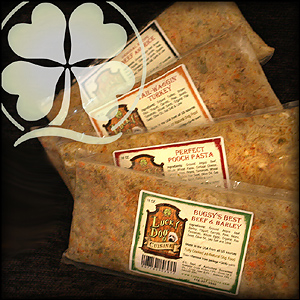
Cardiff's food of choice, Lucky Dog Cuisine, contains human grade, whole food ingredients. Delicious!
This article originally appeared on my blog for
Flexcin International, Inc as
Pet Food Labels: Good Ingredients- Proteins, Grains, Vegetables, Vitamins
Do you read the labels on your pet’s food and treats? You should! Understanding what is actually in your pet’s food is important to ensure your pet is receiving proper nutrition.
The FDA regulates all commercially available pet foods and treats. The label appearing on a product is required to list all ingredients and a guaranteed analysis that the product truly contains the ingredients stated – no more, no less.
This series will focus on helping you understand common ingredients in pet foods. There are
Good, Bad, and Questionable Ingredients that may appear on any given label. In this article, let’s first look closely at Good Ingredients and tips for identifying them.
Proteins
- Focus on feeding whole food based muscle meat protein instead of fractionated counterparts like “meals” and “by-products”.
- I recommend beef, chicken, fish, lamb, pork, rabbit, turkey, and other animal proteins such as heart and liver.
- Legumes, such as beans (black, kidney, red, white, etc), lentils, and peas also provide quality vegetarian sources of protein, fiber, vitamins, and minerals.
Grains
- Grains provide carbohydrates, protein, fiber, and other nutrients like prebiotics, which are substrates on which pro-biotic bacteria grow.
- I recommend barley, brown rice, corn, millet, quinoa, rice, and spelt.
Again, it’s important to focus on whole grains instead of their fractionated forms (corn by-product meal, wheat gluten, soybean mill run, etc.).
Vegetables and Fruit
- Find foods that list whole vegetables instead of hydrolyzed, meal, or starch versions.
- Beet, cauliflower, carrot, eggplant, potato, and spinach provide a healthy source of fiber, phytonutrients, and antioxidants.
- Dried and fresh fruits can also be a part of your pet’s food or added to its diet. Choose richly pigmented fresh fruits like blueberry, cantaloupe, cherry, raspberry, strawberry, and watermelon.
- Avoid grapes and raisins – they contain an unknown toxin that affects dogs’ kidneys. Also avoid dried fruits that contain added sugar and preservatives like sulfur dioxide.
Fat
- Fat is an important part of any diet because it provides the building blocks of muscle and nerve tissue. Pet foods may contain animal and/or plant based fats.
- Animal fat often comes from the rendering process and is likely to contain toxins (heavy metals, carcinogens, etc). For this reason, I recommend fats from other sources.
- Vegetable fats come from many parts of the plant, including fruit (like avocado, olive, etc), kernel, nut, or seed. Extra virgin, cold pressed olive oil and ground flax seed meal (good ‘meal’) are great vegetarian sources of healthy, polyunsaturated fat and omega fatty acids.
Vitamins and Minerals
- Both vitamins and minerals are added to commercially available pet foods to suffice nutritional requirements per industry standard. These are typically synthetic forms that may not be efficiently absorbed as a result of improper binding with receptors inside the digestive tract.
Vitamins and minerals from whole foods more closely fit the body’s receptors and are better utilized.
Now that we’ve covered The Good Ingredients, check back soon for The Bad and The Questionable.
Related Articles
Why You Should Closely Scrutinize Your Pet's Food and Treat Labels
Human Foods That Make Great Pet Treats
Thank you for reading my article. Your questions and comments are completely welcome (I’ll respond).
Please feel free to communicate with me through Twitter (
@PatrickMahaney) and follow my adventures in veterinary medicine by liking
Patrick Mahaney: Veterinarian Acupuncture Pain Management for Your Pets on Facebook.
Copyright of this article (2012) is owned by Dr Patrick Mahaney, Veterinarian and Certified Veterinary Acupuncturist. Republishing any portion of this article must first be authorized by Dr Patrick Mahaney. Requests for republishing must be approved by Dr Patrick Mahaney and received in written format.
 Cardiff's food of choice, Lucky Dog Cuisine, contains human grade, whole food ingredients. Delicious!
This article originally appeared on my blog for Flexcin International, Inc as Pet Food Labels: Good Ingredients- Proteins, Grains, Vegetables, Vitamins
Do you read the labels on your pet’s food and treats? You should! Understanding what is actually in your pet’s food is important to ensure your pet is receiving proper nutrition.
The FDA regulates all commercially available pet foods and treats. The label appearing on a product is required to list all ingredients and a guaranteed analysis that the product truly contains the ingredients stated – no more, no less.
This series will focus on helping you understand common ingredients in pet foods. There are Good, Bad, and Questionable Ingredients that may appear on any given label. In this article, let’s first look closely at Good Ingredients and tips for identifying them.
Proteins
Cardiff's food of choice, Lucky Dog Cuisine, contains human grade, whole food ingredients. Delicious!
This article originally appeared on my blog for Flexcin International, Inc as Pet Food Labels: Good Ingredients- Proteins, Grains, Vegetables, Vitamins
Do you read the labels on your pet’s food and treats? You should! Understanding what is actually in your pet’s food is important to ensure your pet is receiving proper nutrition.
The FDA regulates all commercially available pet foods and treats. The label appearing on a product is required to list all ingredients and a guaranteed analysis that the product truly contains the ingredients stated – no more, no less.
This series will focus on helping you understand common ingredients in pet foods. There are Good, Bad, and Questionable Ingredients that may appear on any given label. In this article, let’s first look closely at Good Ingredients and tips for identifying them.
Proteins
